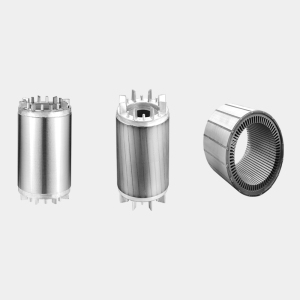电机定子叠片
Motor Stator Lamination: Design, Materials, and Manufacturing Motor stator laminations are thin, stacked steel sheets that form the core of an electric motor's stator. They play a critical role in improving motor efficiency by reducing energy losses, particularly eddy currents, which can generate heat and degrade performance. The design, material selection, and manufacturing processes of stator laminations significantly influence the motor's power density, thermal management, and overall reliability. Design Considerations Stator laminations are precision-engineered with slots or teeth to accommodate copper windings, which create the electromagnetic field necessary for motor operation. The shape and number of slots are optimized based on the motor’s power requirements, torque characteristics, and operating frequency. Key design factors include: - Slot Geometry: Influences winding ease, magnetic flux distribution, and cooling efficiency. - Back Iron Thickness: Affects magnetic saturation and mechanical strength. - Pole Configuration: Determines the motor’s speed-torque profile. Material Selection The most common material for stator laminations is electrical steel (silicon steel), which offers low hysteresis loss and high magnetic permeability. The silicon content (typically 2-3.5%) reduces eddy current losses by increasing resistivity. Laminations are coated with insulation (e.g., oxide or organic films) to prevent interlayer short circuits. Advanced applications may use amorphous or nanocrystalline alloys for ultra-high efficiency, though these materials are more expensive and harder to process. Manufacturing Process 1. Blanking/Punching: Electrical steel coils are fed into progressive dies to stamp out lamination profiles. Laser cutting is used for high-precision or prototype designs. 2. Heat Treatment: Annealing relieves stress from punching, improving magnetic properties. 3. Stacking & Bonding: Laminations are stacked and secured via welding, riveting, or adhesive bonding to form a rigid core. 4. Insulation & Coating: Surfaces are treated to ensure electrical isolation between layers. Key Performance Factors - Core Losses: Minimized through material purity, thin gauges (0.1–0.5 mm), and optimized slot designs. - Mechanical Integrity: Stacks must withstand electromagnetic forces and thermal expansion. - Manufacturing Tolerances: Precision ensures proper alignment with rotors and windings. Applications Stator laminations are used in motors across industries, including automotive (EV traction motors), industrial machinery, HVAC systems, and appliances. Their efficiency directly impacts energy consumption and operational costs. Future Trends Innovations focus on higher silicon steels, hybrid materials, and additive manufacturing for complex geometries. Sustainability efforts drive recycling of steel scrap and reduced material waste during production. In summary, motor stator laminations are a foundational component in electric motors, balancing electromagnetic performance, thermal management, and manufacturability to meet evolving efficiency demands.
产品
分类:
-

叠片电机
所属分类: 冲片、散片浏览次数: 11编号:发布时间: 2025-09-30 15:00:20叠片电机:设计、优点和应用叠片电机是现代机电系统中的关键组件,具有高效率、减少能量损失和卓越的热性能。该类型电机因其紧凑的设计和可靠的运行而广泛应用于汽车、航空航天、机器人和工业自动化等行业。1. 叠片电机简介叠片叠片电机是一种电动机,采用薄的绝缘钢叠片堆叠在一起形成定子和转子铁芯。这些叠片最大限度地减少了实心电机中常见的涡流损耗,从而提高了效率并减少了热量产生。该电机的设计确保了精确控制、高扭矩密度和耐用性,使其适合要求苛刻的应用。2、设计与施工叠片电机的主要特点是其叠片铁芯结构。铁芯由多个薄钢板堆叠而成,每个薄钢板上都涂有绝缘层,以防止它们之间的导电。这种设计减少了涡流——引起能量损失和发热的感... -

电动机定子转子
所属分类: 定转子浏览次数: 12编号:发布时间: 2025-10-07 08:45:12电机定子和转子:机电系统的核心部件电动机是现代技术的基础,为从家用电器到工业机械的一切设备提供动力。每个电动机的核心都有两个关键部件:定子和转子。这些部件协同工作,将电能转化为机械运动。了解它们的设计、功能和交互对于掌握电动机的工作原理至关重要。1. 定子和转子简介定子是电动机的静止部件,而转子是旋转部件。它们共同构成了机电能量转换的核心。定子产生磁场,该磁场与转子相互作用产生扭矩,导致转子转动。该原理适用于各种电机类型,包括 AC(交流)和 DC(直流)电机。2. 定子:结构与功能定子由几个关键元件组成:- 核心:通常由层压钢制成,以减少涡流造成的能量损失。- 绕组:铜或铝线圈排列在磁芯周围的槽中。当通电时...
新闻
分类:
-
[FAQ]安全安装电机定子的最佳实践
2025-10-07 16:59:51
案例
分类:
暂无搜索结果!
视频
分类:
暂无搜索结果!
下载
分类:
暂无搜索结果!
招聘
分类:
暂无搜索结果!
推荐产品
暂无搜索结果!






 手机:+86 13738592999
手机:+86 13738592999 电话:+86(576) 89307999
电话:+86(576) 89307999 邮箱:sales@zjxinzheng.com
邮箱:sales@zjxinzheng.com 地址:浙江省台州市三门沿海工业城
地址:浙江省台州市三门沿海工业城




 Whatsapp
Whatsapp 电话
电话